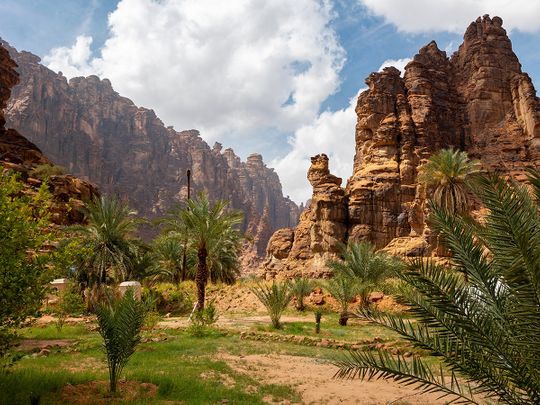
When you think of the desert, you likely think of shifting sand dunes, and scorching weather, where few things can survive. But this is simply not true.
Click start to play today’s Spell It, where we explore some of the desert’s most beautiful locales – ‘wadis’.
Visit Oman, Jordan or even certain spots right here in the UAE, and you’ll see the desert landscape transforming vertically. Soaring limestone cliffs appear, canyons take shape and paths carved by flowing water become apparent. Wadis have existed for millennia in the desert – serving as an sanctuary for wildlife in the winter, and as an oasis from the heat in the summer. Many of these areas once housed ancient cave dwellings, villages, and prehistoric petroglyphs, as well.
Take a look at a few such amazing wadis below:
1. Wadi Shab, Oman
Tucked into the Hajar Mountains in Oman, Wadi Shab lies at the bottom of a massive limestone ridge, one of three wadis in the region. The area is riddled with caves, and is home to the famous Majlis Al Jinn, one of the largest caverns in the world. During the winter, rainwater seeps through the complex of caves and comes together as a flowing spring that runs into the wadis below. Wadi Shab is beautiful, scattered with turquoise pools, and full of wildlife, from kingfishers and herons, to insects and fish. The only way to reach it is by a boat across a deep lagoon, and then on foot.
2. Wadi Rum, Jordan
This protected area, near Jordan’s southern border, is named ‘the valley of the moon’. Mysterious and stunning, Wadi Rum is composed of unique sandstone and basalt rock formations that jut out of its sandy floor. The wadi is nearly as big as the entire US city of New York, and is a popular site for Hollywood film productions because of its red sands and uncanny Mars-like landscape. Wadi Rum also has incredible cultural importance: it is home to over 25,000 petroglyphs and 20,000 inscriptions. About 154 archaeological sites have been discovered in the area, spanning from the neolithic to the Nabatean eras. Excavations have found that different cultures have inhabited Wadi Rum since prehistoric times – over 12,000 years. Many Bedouins still live in the Rum village, in unique goat-hair tents and concrete dwellings.
3. Wadi Al Disah, Saudi Arabia
In the Asir region of Saudi Arabia, Wadi Al Disah offers an unexpected and stunning verdant landscape. As the ‘valley of palm trees’, the mountainous region is home to enormous sandstone cliffs and pillars, and its lush greenery provides the perfect environment for growing crops like tomatoes, citrus fruits and vegetables. A crystal-clear lagoon in the region, known locally as the ‘Blue Eye’, provides an oasis for wildlife and residents, especially in the hot summer months. The site also has historical importance, with its earliest archaeological discoveries dating back to the Bronze age. Wadi Al Disah has quickly grown to become a popular camping and picnic site, and a tourist hotspot at all times of the year.
Have you visited any of these wadis? Play today’s Spell It and tell us at games@gulfnews.com.




